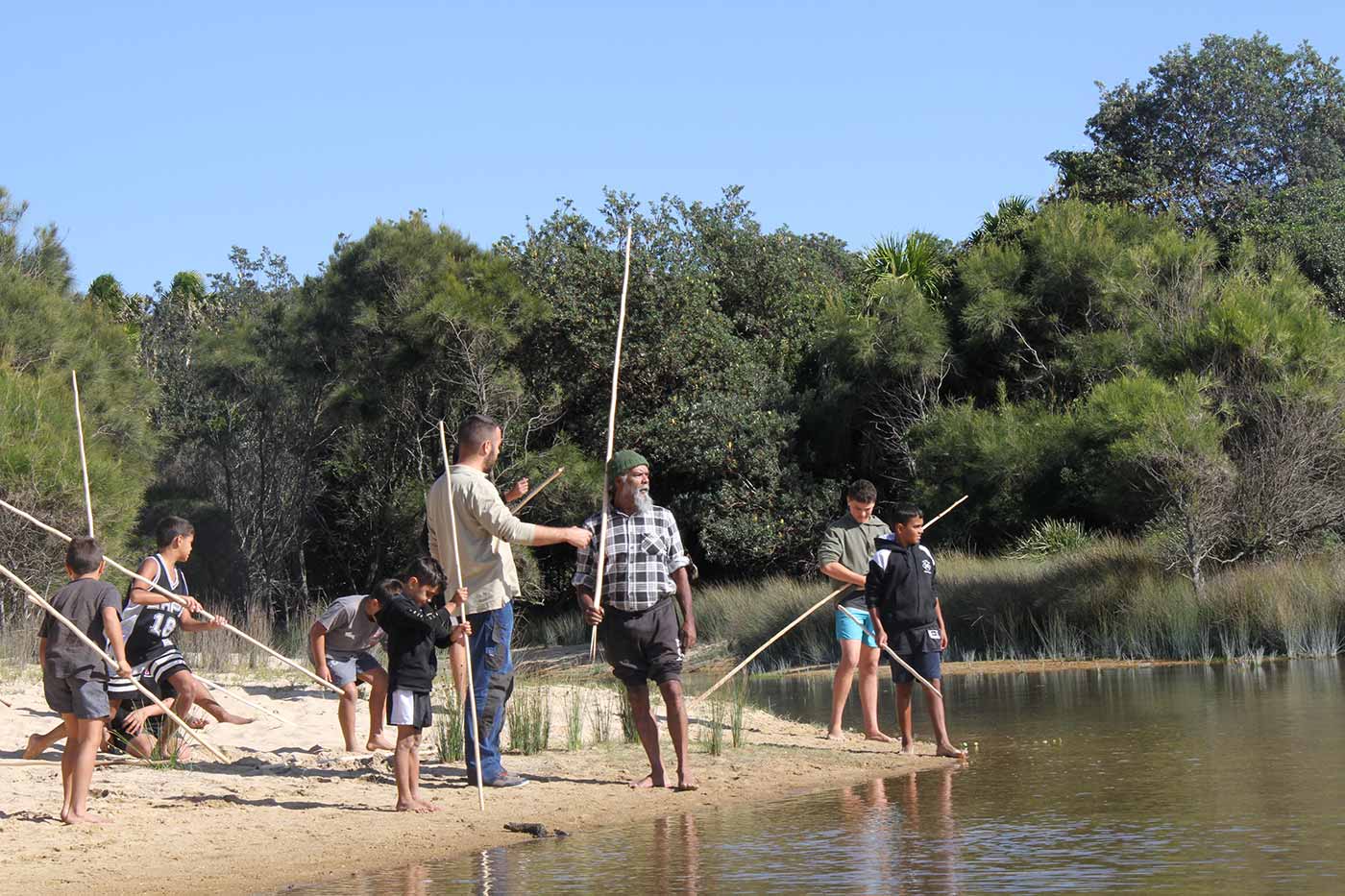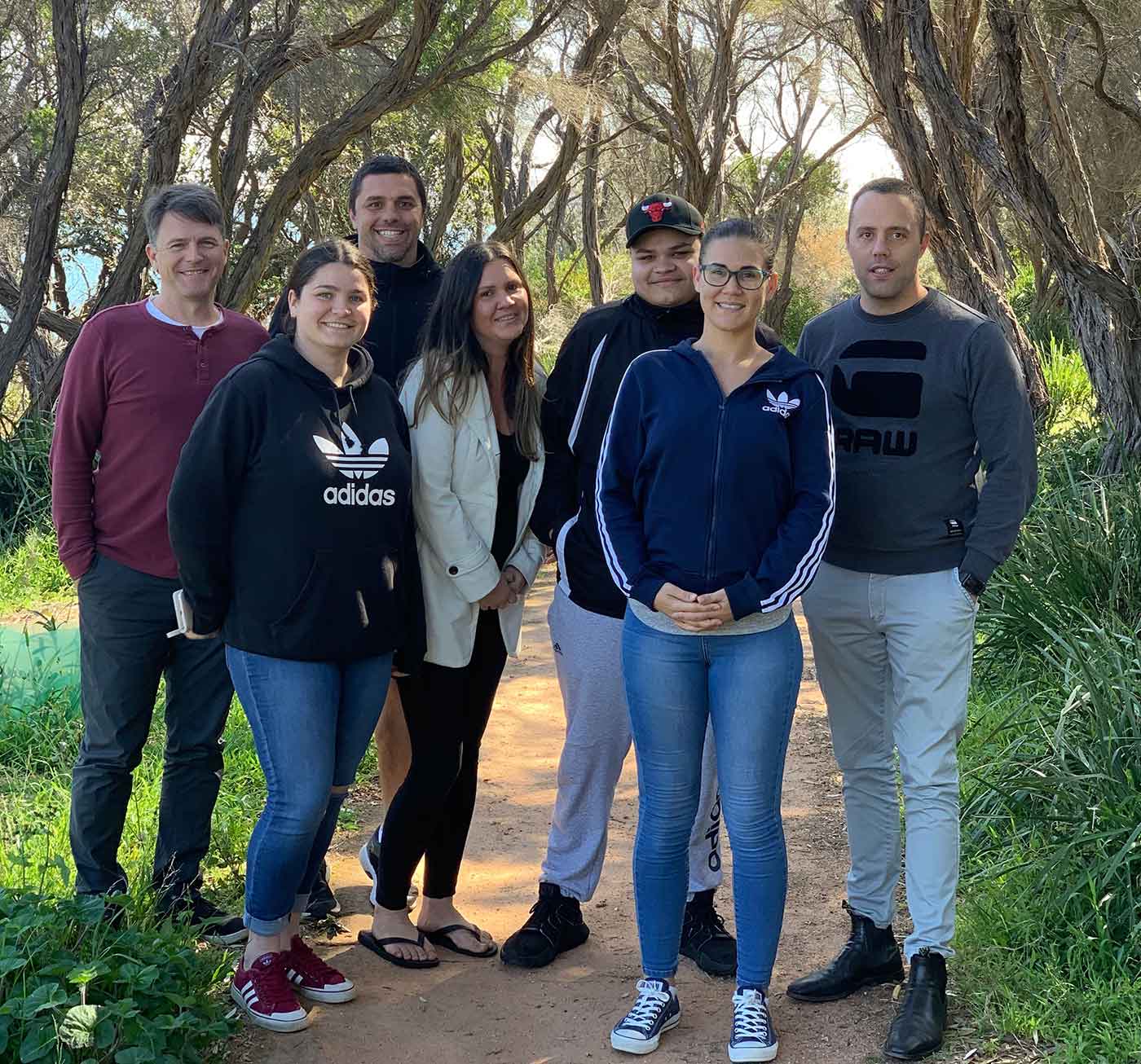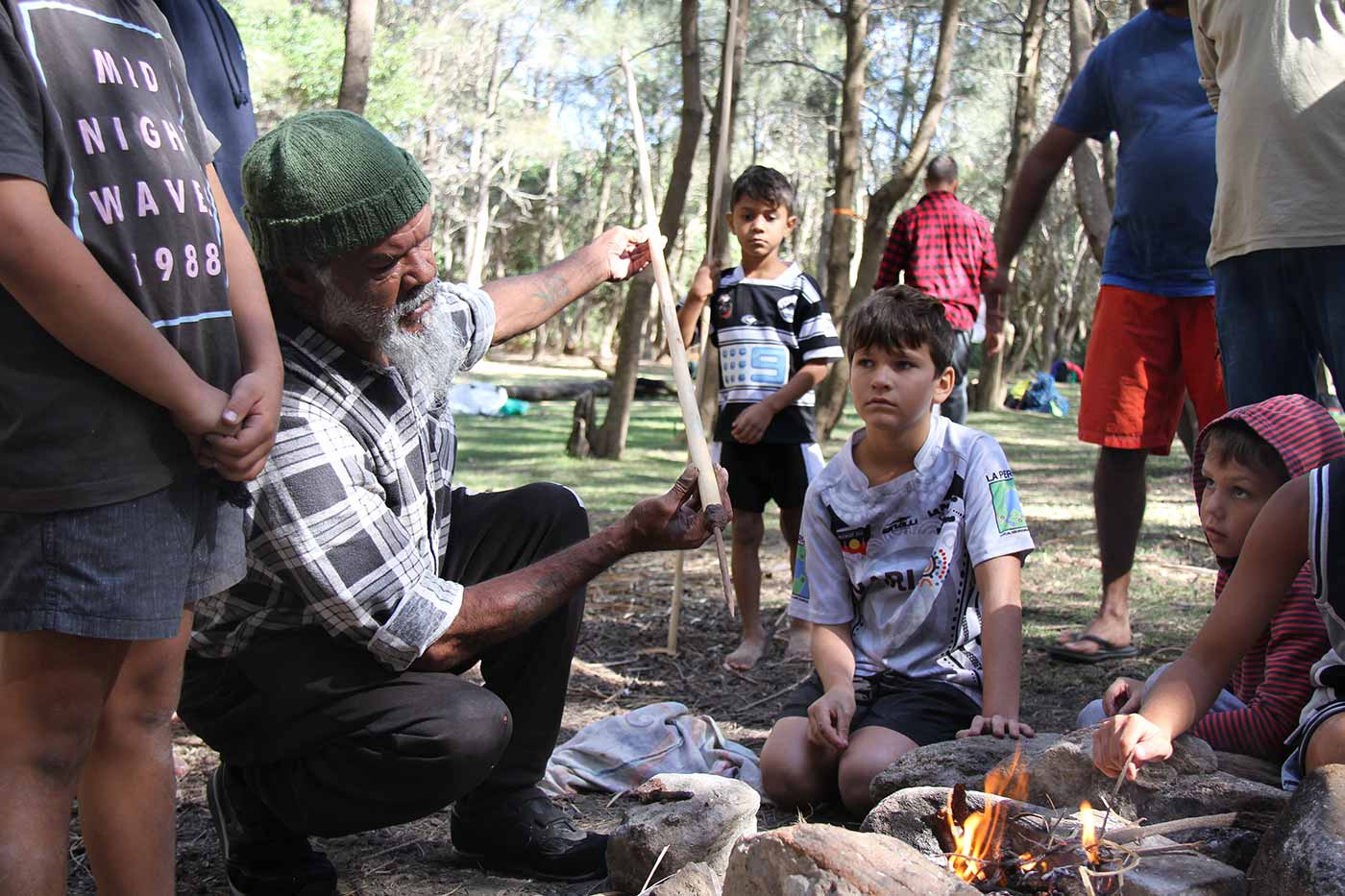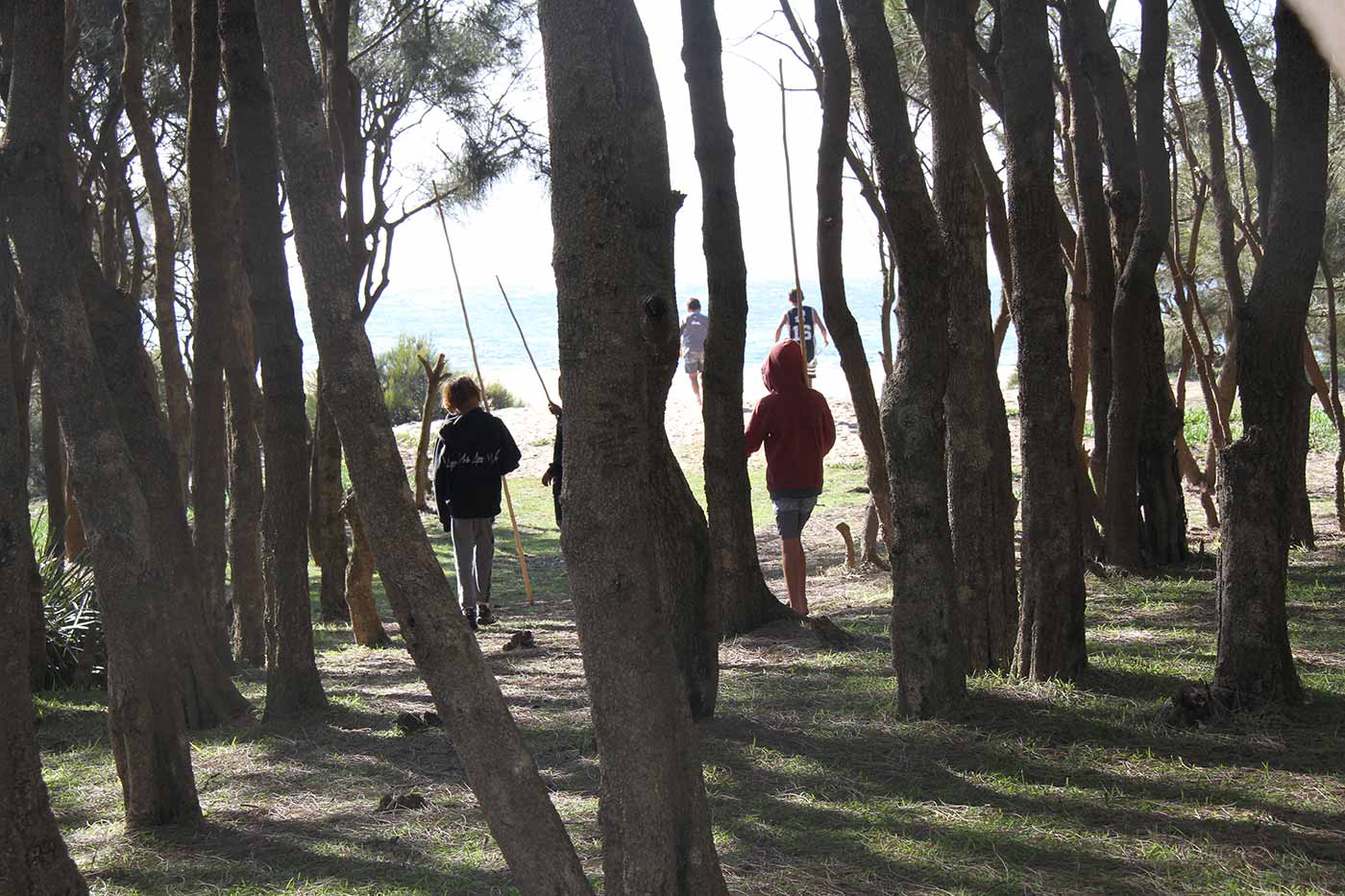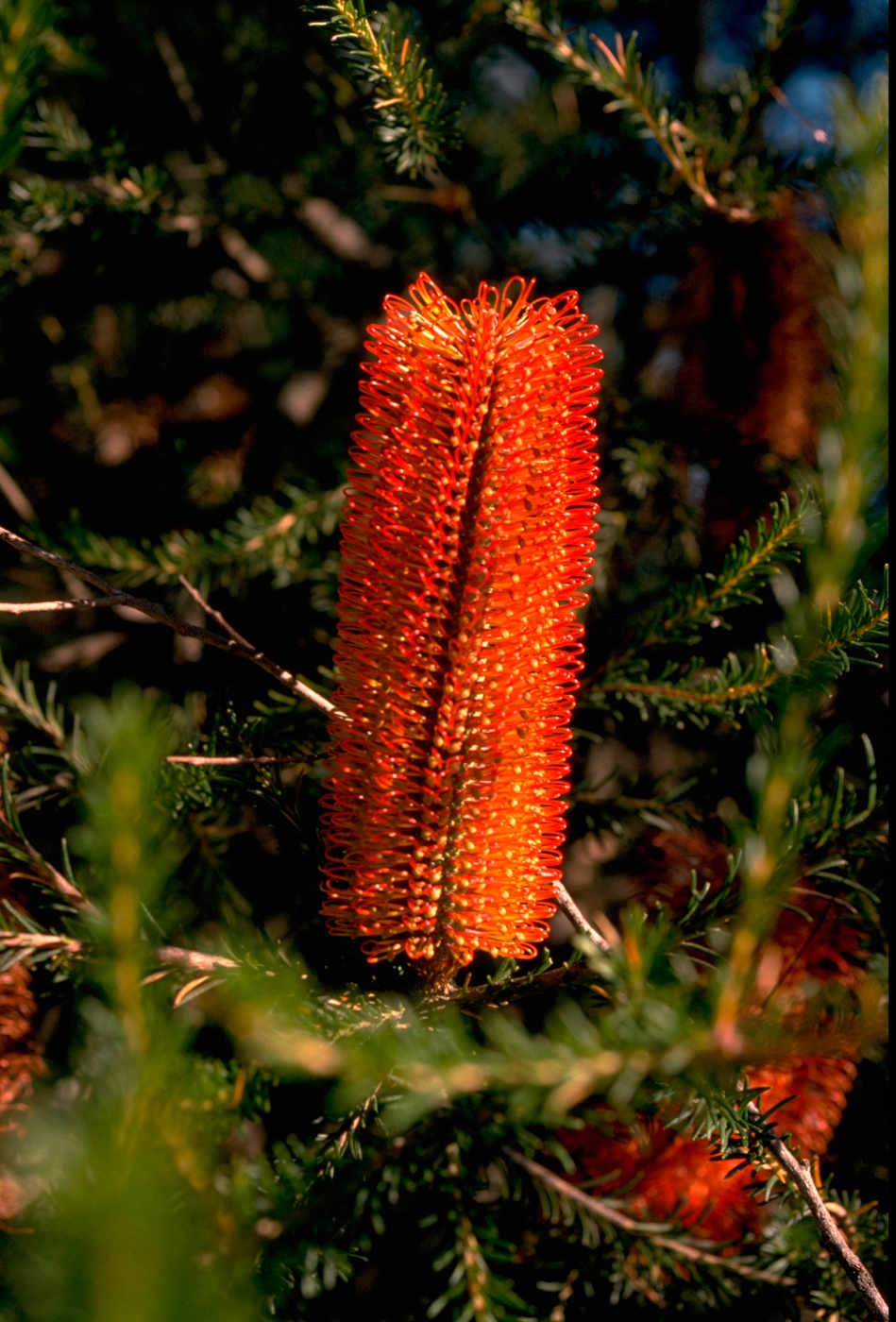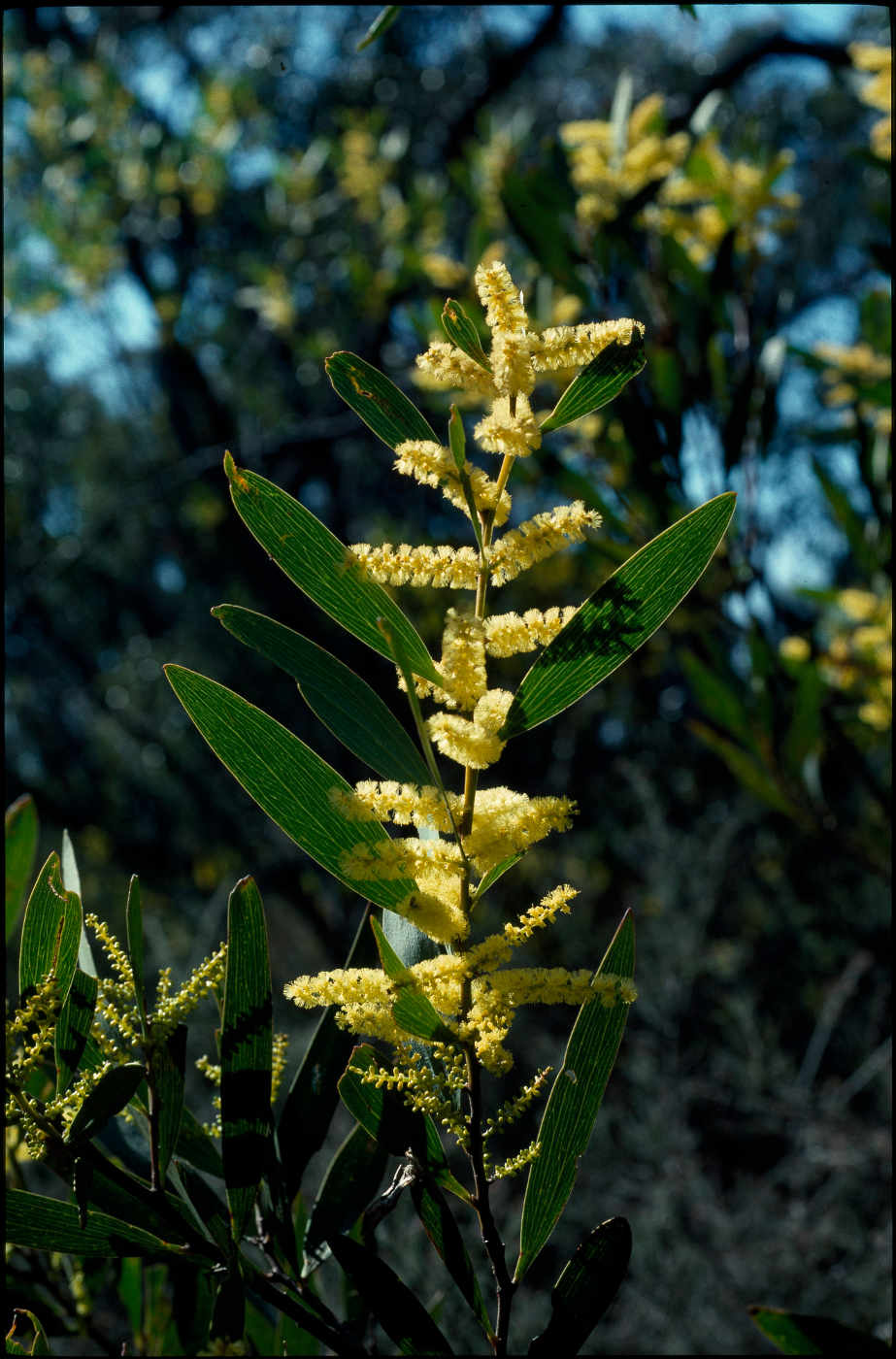Ray Ingrey, Shane Ingrey, Paul Irish, Kodie Mason and Sophie Youngberry of the Gadhungal Research Program reflect on sharing stories, and the stories of the Dharawal ancestors, in the Endeavour Voyage exhibition.
‘We have been waiting a long time for this’ were the words of Uncle Rod Mason, senior Dharawal man and clan leader of the Gweagal. We had just finished filming. There was no brief or script for the elders. All that was asked was to ‘tell us your story, your way’.
The La Perouse Aboriginal Community is situated on the north side of Kamay (Botany Bay). It has been a permanent settlement since the early 1880s, and some of its residents are local Aboriginal families with ancient and unbroken roots to coastal Sydney, including Kamay. In the late 1890s anthropologist RH Mathews stated:
For more than 20 years there has been a camp of aborigines near the village of La Perouse, on the northern shore of Botany Bay. They comprise of all that remains of the descendants of the native tribe that occupied the district at the time of the English occupation of New South Wales in 1788.[1]
These connections were rarely recognised outside of the La Perouse community. Instead, it was widely believed that the people of La Perouse were originally from outside of Sydney. In the late 1980s, senior Dharawal women belonging to the community undertook their own research because of their ‘concern and dismay at the continued misrepresentation of their ancestors’ lives in written history’; a misrepresentation that unfortunately continues today.
Following on from these foundations, the Gujaga Foundation is now leading community and historical research activities within the La Perouse Aboriginal community through the Gadhungal Research Program.
Ray Ingrey, a Dharawal man, coordinates Gujaga’s language, culture and research programs. He is passionate about the need for the local community to work with institutions such as the National Museum of Australia on projects like the Endeavour Voyage exhibition:
Our community has been advocating for our people to ‘tell our story our way’, giving visitors an authentic experience. We also raised the issue of fact-based institutions in the past promoting information that is not consistent with our community or is contrary to evidence.
So to bring confidence to the National Museum, the content we develop and suggest for the Endeavour Voyage exhibition is also backed up by research evidence. These were our guiding principles when we first discussed the project with the museum and to our surprise were received well by them.
Learning more about our ancestors
Working on the exhibition gave the Gadhungal team an opportunity to collaborate with key community members including senior Gweagal people, and to explore the important historical events of 1770 from the perspective of the ‘shore’.
Members of the team have direct kinship relationships with ancestors connected to these events. Sophie Youngberry is a community researcher and belongs to the Gweagal clan of the Dharawal nation. Sophie’s great-great-grandmother, Dolly Anderson, was the younger sister of Burraga (Joe Anderson), King of the Dharawal people. Finding more about Joe’s knowledge of these events through direct family connections has been personally empowering for Sophie:
It has instilled a strong foundation of my own identity and how closely I connect with my family and wider community.
Sophie also found it interesting to read the detailed accounts of the Endeavour’s crew and think about the recorded events from a cultural perspective. Banks’s judgement of our people as ‘rank cowards’[2] has been repeated often simply because it was written down, but that’s just one side of the story, as Sophie affirms:
Looking closely at the records of the Endeavour, and comparing it to our people’s cultural knowledge and perspectives of what was happening, there’s no doubt in my mind that there is a remarkable story to be told from our people along the shoreline. Our ancestors did not avoid the Endeavour crew because they were cowards. They had cultural reasons for everything that they did.
Understanding Cook
Everyone involved in developing the content for the Kamay section of the exhibition is looking forward to visitors learning about the Endeavour voyage. Like most people, in primary school the team members were provided with a one-sided story of Cook, but through working on this project there has been much to discover about both sides of the story.
It has been told by Dharawal elders that our ancestors knew something was coming before the Endeavour arrived. Through research we have unearthed more details, including how the people in Kamay received ‘letter sticks ... from tribes in the south’ to let them know about this unidentified floating object.[3]
The team also learnt how Cook and Banks changed their view of Aboriginal people as they headed north and spent more time interacting with other groups. Paul Irish, a non-Indigenous historian and experienced researcher who has been working with the Gadhungal Research Program for more than a decade, reflected on the missed opportunity during the Endeavour’s eight days in Kamay:
It makes us wonder what might have been if both groups had been able to engage with each other; if Aboriginal people had the opportunity to explain local cultural and language information relating to Kamay. This makes us value even more the knowledge that has been passed down and has survived.
Working with family
The La Perouse Aboriginal community is a somewhat private community where it is difficult, without having a ‘view’ from within, to see what cultural knowledge still exists. From the perspective of being a first contact community, it is remarkable to find that a considerable amount of cultural knowledge remains. The team worked closely with Dharawal elders and knowledge holders to ensure the cultural knowledge captured for the exhibition was local, accurate and appropriate.
Banks records that during the Endeavour’s stay at Kamay the crew took 40 to 50 spears.[4] For the team it was important to not only support bringing back from England three of the four remaining spears, which undisputedly originated from Kamay, to be part of the exhibition, but also to show visitors how the making and use of spears continues today within the community.
The team engaged senior Gweagal clan leader and craftsman Uncle Rod Mason to share his knowledge of this ancient practice and provide an opportunity for it to be passed on to the next generations — as he has been doing for many years with his numerous nephews and great-nephews at Kamay. In addition to being a master spear-maker, Uncle Rod has extensive knowledge of native plants and their uses within Dharawal country.
Kodie Mason, a community researcher who also belongs to the Gweagal clan of the Dharawal nation, worked closely with Uncle Rod, her grandfather, to look at the various traditional plant uses and how best to present them in the exhibition.
Since I could remember, I was always learning from my pop about our culture and family. Working with my pop on this project has allowed me to gain a deeper understanding of my family’s knowledge. Plants have always been an important part of our culture and livelihood as they provide us with food, medicine, shelter, materials, and play an integral part in many ceremonies.
This knowledge has been passed down from generation to generation.
'Discovery'
The one-sided perspective of the arrival of Cook into Kamay always states that Cook ‘discovered’ Australia, Banks ‘discovered’ new plant species, and the British named it ‘Stingray Bay’ then decided on ‘Botany Bay’. That seems obvious when the only story you have heard is that of the Endeavour landing at Botany Bay.
However, when the stories from the shore start to emerge you can only begin to wonder who ‘discovered’ who or what first. One story in particular from Burraga, King of the Dharawal people, starts the curiosity. Burraga told a news reporter in 1937:
My grandfather met Captain Cook at Kurnell. Runners from tribes in the south had brought him ‘letter sticks’ telling of the coming of the white man.[5]
We can legitimately ask, ‘Who discovered who?’
Dr Shane Ingrey, a Dharawal man, provides academic and scientific advice to the Gadhungal team. He was awarded his doctorate in 2015 for working on microbial or medicinal associations with native plants found around Kamay. Dr Ingrey touches on the ‘discovery’ of Botany Bay, but goes further to challenge the ‘discovery’ of botanical species — the main reason for Banks’s costly ticket on the voyage:
Our people called the bay Kamay. It already had a name. On the plants, the Dharawal people would have been the expert botanists and the leading scientists when it came to plants and their uses from around coastal Sydney and Kamay.
Can places, flora and fauna be ‘discovered’ when there already has been the transmission of knowledge about them over many generations or since time immemorial? When you consider there are Dharawal names for each plant local to Kamay, along with classification systems, knowledge of plant harvest times, on how a plant is managed in the environment, and how it can be used as food or for medicinal purposes. What else is there to ‘discover’?
Dr Ingrey reflects on his own PhD work and how that has connected to the content of the Kamay section of the exhibition:
I worked closely with senior Dharawal women to select the plants to research and the knowledge that came with the plants. Being involved with this exhibition, I got to work with family around the plants and their uses, including some of the grandchildren, great-grandchildren and great-great-grandchildren of those senior women.
It was inspiring for me to continue my learning around the knowledge of these plants but more importantly to see that existing, continual, cultural knowledge flows around Dharawal plant use.
Misunderstood words
The Endeavour Voyage exhibition provided the team with resources to work collaboratively across a range of areas relating to the eight days the Endeavour stayed in Kamay. This enabled work in areas that included the review of language materials, diaries and other historical documentation, and engagement with elders and knowledge holders.
Previous community-led work has been undertaken with limited resourcing and 90 per cent of the team volunteering their time. When resourced appropriately, the opportunities to get the story of the community out are far greater. Research into the first words spoken to and documented by the crew of the Endeavour is a prime example.
To set the scene, it was the afternoon of Sunday 29 April 1770. Cook led a party of several dozen men in two boats to land at Kurnell. As they drew close it was observed by Sydney Parkinson that:
two men, with different kinds of weapons, came out and made toward us. Their countenance bespoke displeasure; they threatened us, and discovered hostile intentions, often crying to us, Warra warra wai.[6]
Both Banks and Parkinson noted the seemingly threatening gestures that the men made, but Parkinson did not provide any thoughts as to what ‘warra warra wai’ might mean. Cook was right there too, but he later recorded that he failed to ‘understand one word they said’.[7]
Even when you fast-forward 18 years, the same words were recorded by members of the First Fleet, spoken by armed men on the headlands of Kamay and Sydney Harbour. Like Parkinson, most simply recorded the combination of words and gestures. One observer, the Reverend Richard Johnson, putting two and two together, still made it clear that the meaning was assumed:
As we came near them they spoke to us in a loud dissonant Manner, principally uttering these words — ‘Warra, Warra, Wai’, which we judged to be to tell us to go away.[8]
These uncertainties in meaning were lost when variations of the words appeared in several early Aboriginal language word lists to simply mean ‘go away’. Despite the uncertainty all those years ago, the words ‘warra warra wai’ are still often interpreted as ‘go away’ (see also The story from the shore). But when it is explained from the ‘shore’ perspective, a more certain explanation starts to emerge.
Aboriginal spiritualism is a way of knowing. It explains the understanding and interpretation of existence, knowledge, connections and place in the universe as spiritually founded; this is also called the Dreaming. According to Ray Ingrey:
Our people are spiritual people. One of our Dreaming stories tells how spirits of our old people who have passed away travel back in low-lying clouds and return to Dharawal country as ghosts. So when our old people saw the crew of the Endeavour, a logical spiritual explanation was they are all spirits of the dead returning.
In Aboriginal cultures, non-verbal communication is a key part of everyday communication and serves as a gestural language that could be understood across other tribal groups with different languages, when hunting or communicating at distances. Not so prominent in European-influenced cultures, these behaviours when viewed through a Western lens could easily be misunderstood, dismissed or not recorded at all.
The English interpretation of ‘warra warra wai’ as ‘go away’ would have been based on personal interpretations about the gestures that accompanied the words. The raised spears and shouted words appeared to Europeans as signs of aggression and warning. But this assumed that gestures have universal meanings.
The Dharawal Language Program has been responsible for language reclamation in the La Perouse Aboriginal community. The program’s Ray Ingrey explains the meaning of ‘warrawarrawai’:
In Dharawal the word ‘warra’ means dead and is associated with the colour white. When we emphasise something we double the word. The suffix ‘-wai’ on the end of the warrawarra means ‘they all’, so from a Dharawal language perspective the words being said in 1770 and then 1788 mean ‘they are all dead’ and not ‘go away’.
In Dharawal culture, contact with spirits from the afterlife was mostly avoided by the general community. The avoidance behaviours observed by the crew of the Endeavour could also indicate that local people were seeing the events through a spiritual lens.
Sharing our story
The opportunity to develop content for the Kamay section of the Endeavour Voyage exhibition has fulfilled the wishes of our community to tell our story our way and provide opportunities for each visitor to engage with local, authentic and culturally appropriate content and, most importantly, to view the historical events of 1770 through a different lens.
We want visitors to understand how our people would have experienced these events because they were participants not spectators. There are two sides to this story and although it may not have been a positive encounter, it is our shared history nonetheless.
[1] Robert Hamilton Mathews, Papers of Robert Hamilton Mathews, National Library of Australia, MS8006, Series 3, Box 3, File 3.
[2] Banks’s journal, 4 May 1770.
[3] ‘Rivals must keep off the grass, declares Aboriginal King', Sun (Sydney, NSW), 6 March 1937, p. 2, http://nla.gov.au/nla.news-article230337758, viewed 13 March 2020.
[4] Banks’s journal, 28 April 1770.
[5] 'Rivals must keep off the grass, declares Aboriginal King'
[6] Parkinson, A Journal of a Voyage to the South Seas, Stanfield Parkinson, London, 1773, p. 134.
[7] Cook’s journal, 29 April 1770.
[8] Richard Johnson, letter to Henry Fricker, 10 February 1788, Safe 1/121, Mitchell Library, State Library of NSW, Sydney.
